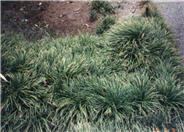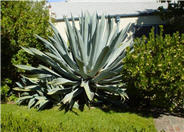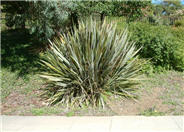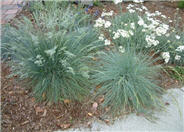
Common name:Mondo Grass, Lily Grass
Botanical name:Ophiopogon japonicus
This Ophiopogon japonicus is a grass-like plant growing to about 6"-8" high. Its leaves are 1/8" wide, and about 8"-12" long. It makes a beautiful ground cover or accent plant, and does well in Asian style gardens.

Common name:Century Plant, Maguey
Botanical name:Agave americana
This plant is fast growing to about 6'-10' tall and 8'-13' wide. Wide gray leaves have stiff terminal spines and recurved teeth on margins. It prefers full sun and well-drained situations. After blooming, which could take several years, it will die but will send up new pups from around the base. Some people are allergic to the sap. Removal is difficult if unwanted.

Common name:New Zealand Flax
Botanical name:Phormium tenax
New Zealand Flax is a large, bold plant with stiffly vertical, sword-like, green leaves that arise from its base. It should be grown under full sun for best color. Varieties will offer different growth habits and leaf color.

Common name:Blue Fescue
Botanical name:Festuca glauca
This ground cover/grass will grow less than 1' tall and has small, blue green leaves.
Designer: Billy Goodnick
Photographer: GardenSoft
Practice grass-cycling by leaving short grass clippings on lawns after mowing, so that nutrients and organic matter are returned to the soil.
Group plants in your garden according to their water needs (hydrozone).
Drip and other smart irrigation delivers water directly to roots, allowing no excess water for weeds.